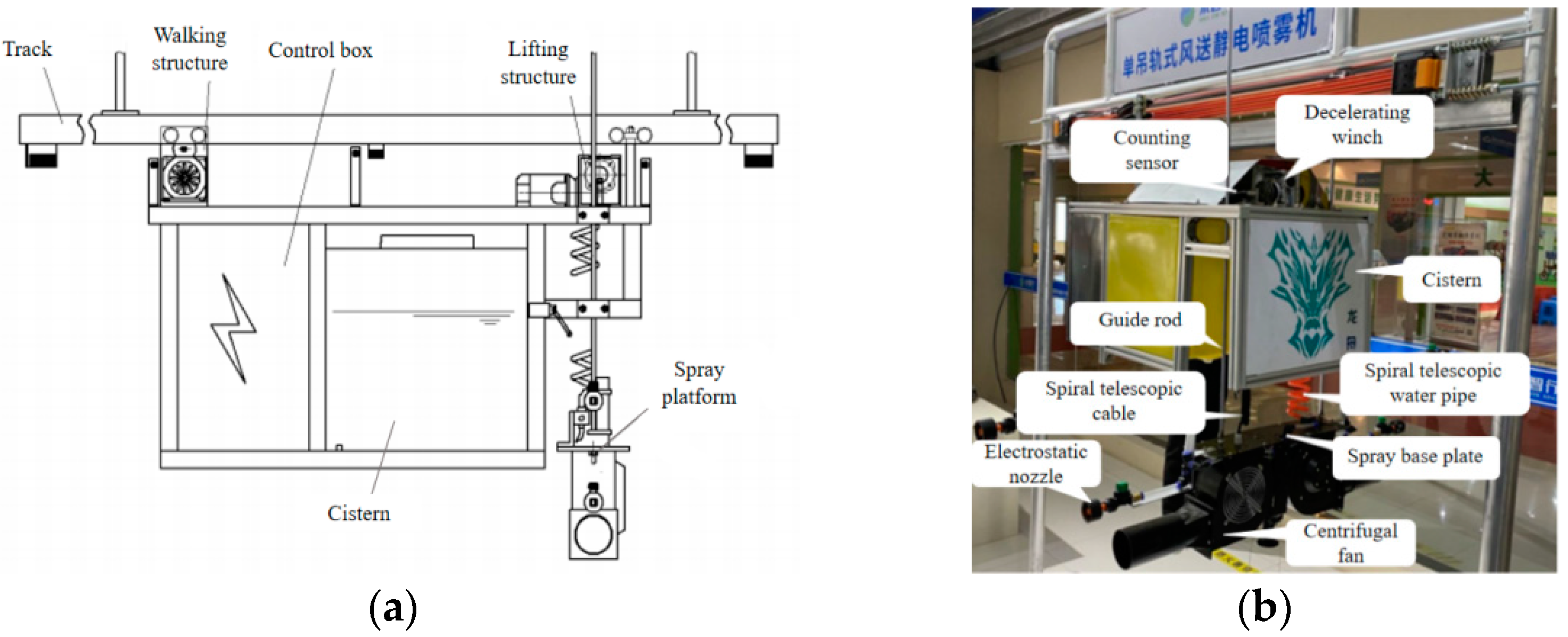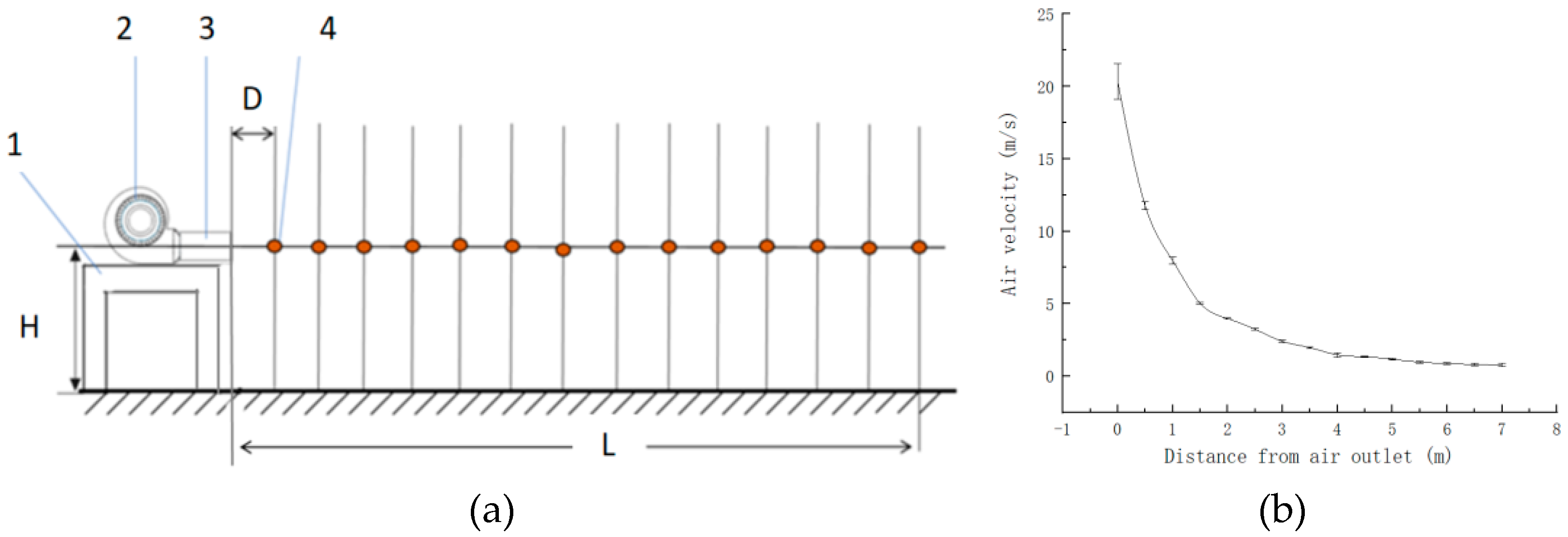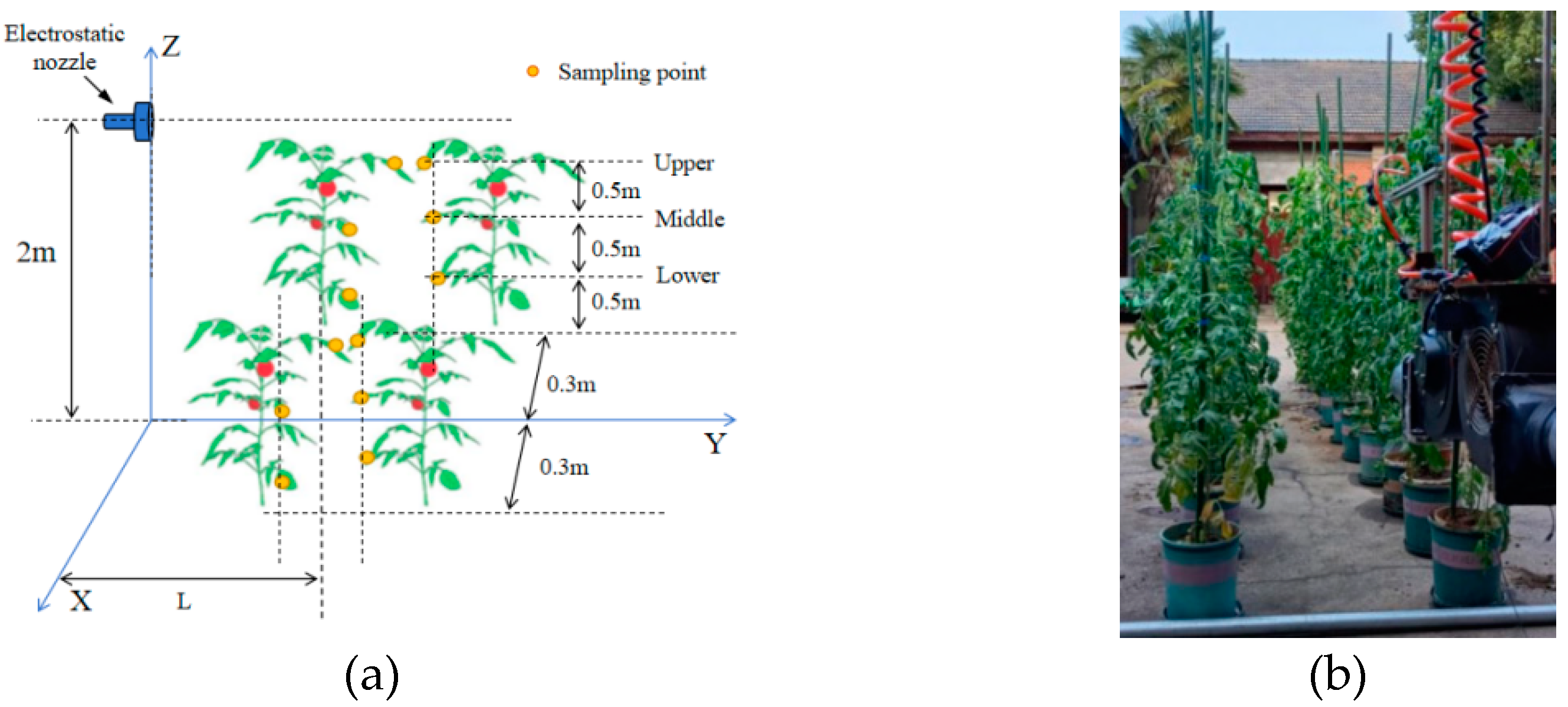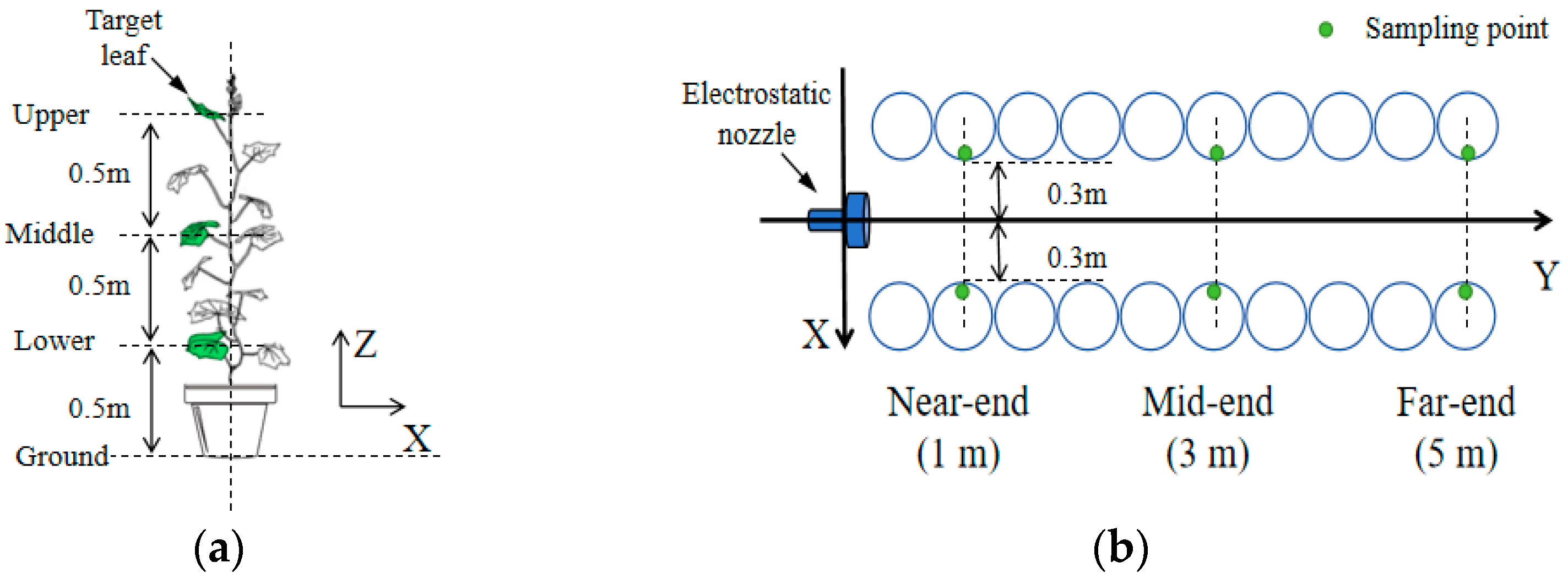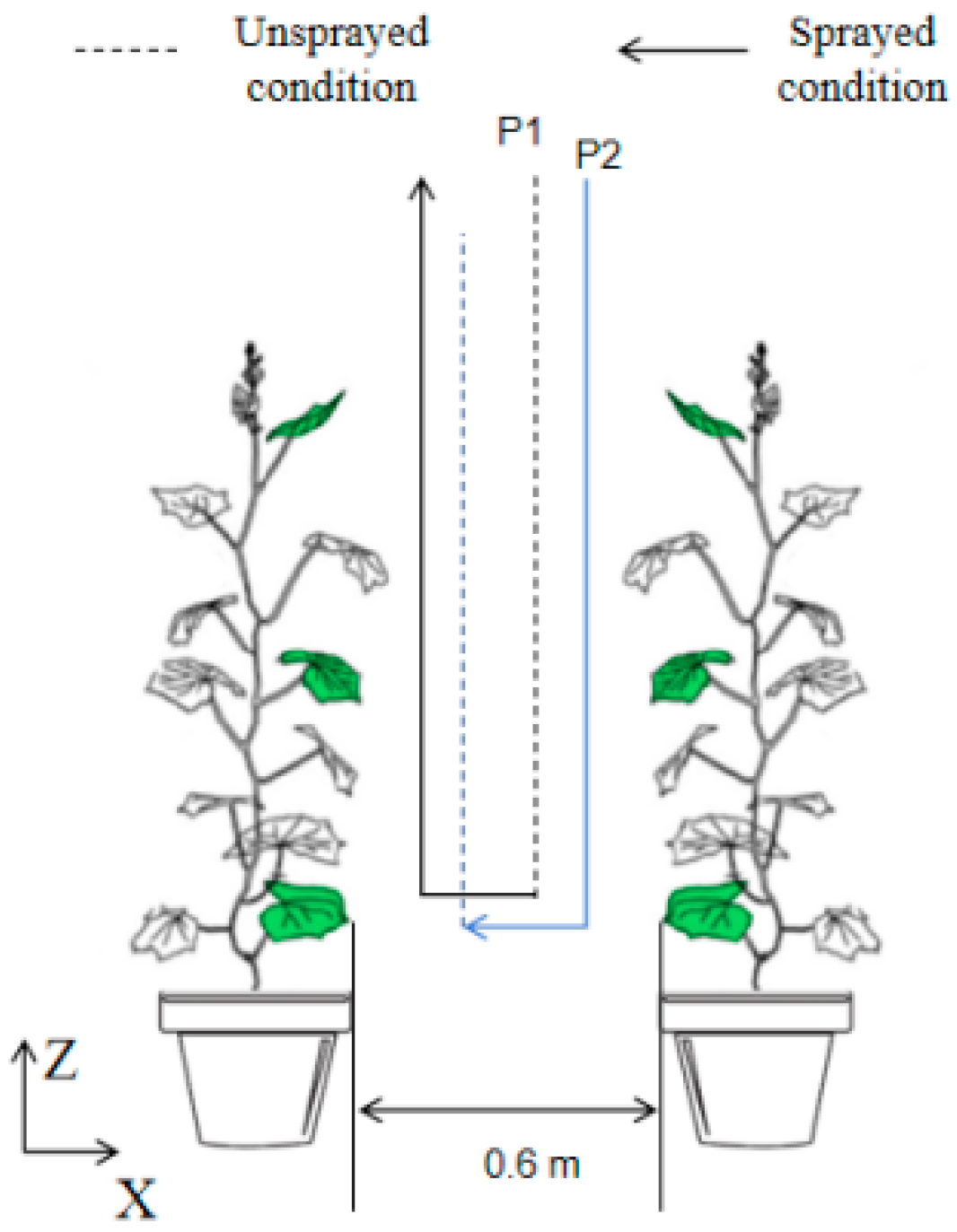1. Introduction
A greenhouse environment has the characteristics of high temperature and humidity, lack of natural enemies of pests, high planting density of crops and so on. It is easily affected by pests and diseases in the actual production process [
1,
2]. Due to the intensive planting of greenhouse crops, there are many problems in the greenhouse application environment, such as narrow crop rows and dense canopy. This makes it difficult for traditional manual sprayers and backpack sprayers to effectively deposit pesticide solution on the surface of the middle and lower leaves of crops during application, and it also increases the health risks for its operators [
3,
4,
5]. In order to cope with the complex working environment, more and more efficient spraying technologies have been put into use, including air-assisted spraying technology, electrostatic spraying technology, air-assisted electrostatic spraying technology, etc. [
6,
7,
8].
Air-assisted spraying technology refers to the plant protection machinery in the process of spraying crops through the fan generated by the airflow field; the droplets are transported to the target position and deposited on the target crop surface. In the airflow field, crop leaves will also be disturbed by the airflow field, which improves the droplet deposition amount, penetration and deposition uniformity on the back of leaves and inside the canopy [
6,
9,
10,
11]. In air-assisted spraying, the main factors affecting droplet deposition on crop leaf surface are air velocity, spray distance, moving speed of spraying platform, etc. [
12,
13].
Electrostatic spraying is a spraying technique that charges droplets. When the charged droplet cloud composed of many charged droplets approaches the plant leaves, an induced electric field will be formed around the target leaves, so that the charged droplets will be affected by the electric field force near the target leaves, and the status quo of “electrostatic deflection and circling” will appear, thus reducing the droplet drift and improving the deposition of charged droplets on the target leaves [
14,
15]. In electrostatic spraying, the main factors affecting droplet deposition on crop leaf surface are charging voltage, spraying pressure, spraying height, droplet size, etc. [
16,
17,
18].
Air-assisted electrostatic spraying technology combines the advantages of air-assisted spraying technology and electrostatic spraying technology, which can effectively improve the droplet deposition coverage of spray distance. In addition, air-assisted electrostatic spraying technology also inherits many factors that can affect the deposition effect of air-assisted spray and electrostatic spray. These influencing factors mainly include charged voltage, spray distance, spray pattern, air velocity and spray pressure [
19,
20,
21].
At present, there are few studies on the influence of air-assisted electrostatic spraying platform dynamics on droplet deposition coverage, and the related studies are not comprehensive. Dai et al. examined the effects of spray pressure, air pressure and applied voltage on droplet size and charge-to-mass ratio [
19]. Neto et al. compared the effects of different spray volumes and charges on spray deposition [
20]. Zampiroli et al. evaluated the control effect of different spray rates and different nozzles [
21]. These studies mainly compared the different spray pressures, different air pressures, different types of nozzles, charge sizes and other factors in the spray deposition effect. There are few studies on the polarity of charging voltage and the spray pattern of the sprayer.
In this paper, the effects of different polarity charging voltages (0, +10 kV, −10 kV), spray distances (1, 3, 5 m) and spray patterns (ascending spray, descending spray, fixed height spray) on droplet deposition coverage on the upper, middle and lower tomato leaves were investigated by using the greenhouse single-rail air-assisted sprayer [
22] developed by Jiangsu University. Three regression equations were obtained between the polarity charge voltage, spray distance, spray pattern and droplet deposition coverage on tomato leaves in each layer. The purpose of this study was to explore the charging voltage polarity and spray pattern suitable for this air-assisted electrostatic sprayer. And it provided a reference for greenhouse air-assisted electrostatic sprayer application.
2. Materials and Methods
2.1. Equipment
The greenhouse single-rail air-assisted electrostatic sprayer used in this experiment was developed by Jiangsu University. Its main structure consists of a control box, cistern, lifting structure, spraying platform, walking structure and track. There is a rotary atomizer in the middle of the spray platform for spraying the area directly below the machine location. However, since the test does not involve walking spray and does not measure the spray effect in the area directly below the spray platform, the function and effect of the walking mechanism and rotary atomizer are not described too much. The structure of the sprayer is shown in
Figure 1.
The lifting structure of the sprayer is mainly composed of a single-phase AC motor, winch wheel, worm reducer and guide rod. Two winch wheels are, respectively, fixed at two ends of the worm reducer, and the lifting movement of the spraying device is realized by winding and retracting the steel rope. The lifting motor configuration has a brake function and can realize the lifting function of power failure that is stopped. In addition, the worm reducer also has a self-locking function to ensure that the rising speed is consistent with the falling speed.
The spray platform consists of two centrifugal fans (YWL 2E-150, Hangda Electric Co., China) and four electrostatic flat-fan nozzles (FVP 110-02, HYPRO Manufacturer Co., USA). The two fans and four electrostatic flat-fan nozzles are symmetrically fixed on two sides of the bottom plate of the spraying device, respectively, so that the spraying device can simultaneously apply pesticide to crops in two directions. The electrostatic nozzle is fixed above the air outlet of the fan, so that the droplets have sufficient charging time. The spray angle of the electrostatic nozzle is 110°, and inductive charging is adopted. Its main operating parameters are shown in
Table 1.
2.2. Air Velocity Measurement Test
In order to understand the variation in air velocity during spraying, the air velocity along the axis of the centrifugal fan outlet was measured. The test was conducted in a corridor at Jiangsu University with a length of 10 m, a width of 2 m and a height of 3 m. The test was measured by a handheld anemometer, and the wind speed change within the range of 0–7 m from the air outlet in the axis direction of the air outlet was measured. The measurement point interval was 0.5 m (
Figure 2a). The test results are shown in
Figure 2b.
According to the curve of air velocity change in
Figure 2b, the attenuation of air velocity is faster in the range of 0–3 m, and the attenuation of air velocity is gentle in the range of 3–7 m.
2.3. Deposition Test Arrangement
The application scenario of the greenhouse single-rail air-assisted electrostatic sprayer is a solar greenhouse in Shouguang City, Shandong Province. The main crops planted in the solar greenhouse are tomato, eggplant, cucumber and other crops, which are planted in the close planting mode. The ridge distance between two rows of crops is 1.2 m; the canopy distance of mature crops is approximately 0.6 m; and the length of single crops is approximately 12 m. The greenhouse single-rail air-assisted electrostatic sprayer is hung on the greenhouse beam through the rail and suspended above the crop canopy. During spraying, the sprayer moves to the middle of two rows of crops and sprays with the aid of the lifting structure.
The experiment was carried out in Jiangsu University agricultural machinery compound using the greenhouse single-rail air-assisted electrostatic sprayer. The tomato crops used in the experiment were potted tomatoes planted in a self-built small greenhouse. In the experiment, the placement method was intended to simulate the planting method in the Shouguang greenhouse, as shown in
Figure 3.
In the greenhouse spraying operation in Shouguang, the crops in the working scene of the greenhouse single-rail air-assisted electrostatic sprayer are located at both ends of the machine horizontal direction (
Y axis direction) and have certain symmetry; therefore, the tomato leaves at one end are selected to arrange the sampling points. In order to reflect the law of droplet deposition on the surface of each layer of tomato leaves, the sampling points are divided into upper, middle and lower layers from the height direction (
Z axis direction); each layer is 0.5 m apart, and the upper tomato leaves are approximately 1.5 m above the ground (
Z axis direction). And from the horizontal distance direction (
Y axis direction), they are divided into near-end, mid-end and far-end. The distance is 2 m, and the distance between the near-end and the air outlet in the horizontal direction is 1 m. The sampling point layout is shown in
Figure 4.
During the test, the outdoor temperature was 27 °C, the humidity was 44%, and there was no wind.
2.4. Experimental Factors
There are many factors affecting the droplet deposition coverage of air-assisted electrostatic spray on tomato leaf surface, including but not limited to the charging voltage polarity, spray distance, spray pattern, spray height, spray angle size and target characteristics. The three factors selected in this experiment are the charging voltage polarity, spray distance and spray pattern, and the other conditions remain the same. In order to facilitate the subsequent data processing and calculation, X
1 represents the charging voltage polarity; X
2 represents the spray distance; X
3 represents the spray pattern; Y
1 represents the droplet deposition coverage on the upper tomato leaf surface; Y
2 represents the droplet deposition coverage on the middle tomato leaf surface; and Y
3 represents the droplet deposition coverage on the lower tomato leaf surface. X
1, X
2 and X
3 are the independent variables; Y
1, Y
2 and Y
3 are the dependent variables; and droplet deposition coverage is used as an evaluation index. The factor levels tested are shown in
Table 2.
Among them, the spray patterns are divided into ascending spray, fixed height spray and descending spray, and the ascending velocity direction of the ascending spray is taken as the positive direction; therefore, the ascending spray velocity is +0.3 m/s, the fixed height spray velocity is 0, and the descending spray velocity is −0.3 m/s (
Figure 5).
Ascending spraying: spray for 3 s from 0.5 m above the ground (Z axis direction), then rise at +0.3 m/s and spray at the same time. When the spraying platform rises to 2 m above the ground, it stops rising and continues spraying for 2 s before stopping the application operation. The time required for rising is 5 s.
Descending spraying: spray for 3 s from 2 m above the ground (Z axis direction), then descend at −0.3 m/s and spray at the same time. When the spraying platform descends to a height of 0.5 m above the ground, it stops descending and continues spraying for 2 s before stopping the application operation. The descending time is 5 s.
Fixed height spray: spray continuously for 10 s at a position 2 m away from the ground (Z axis direction).
In order to determine the optimum spray parameter combination of air-assisted electrostatic spray, response surface methodology was used to design the experiments. The Box–Behnken orthogonal test method was used to select the test groups. And the Develve software (Version 4.16) was used to generate the test schemes. A total of 17 groups of tests were obtained, as shown in
Table 3.
2.5. Data Processing and Analysis
In this test, droplets were collected using a 15 mm × 20 mm white paper card. Before each experiment, white paper cards were fixed on the target leaves of tomato plants with paper clips as droplet collection devices. In order to observe the effect of droplet deposition, carmine solution with a concentration of 5 g/L was used for spraying. In order to ensure that the test data are not contaminated by other factors, at the end of each test, the white paper card needs to be dried and stored separately in a sound self-sealing plastic bag.
At the end of the test, the white paper card used to collect droplets was brought back to the laboratory. For the collected white paper card, the following steps need to be performed: (1) Scan one by one with a scanner into digitized .jpg format files; (2) Adjust image digits; (3) Binarization; (4) Adjust threshold; (5) The droplet deposition coverage is obtained by the software Depositscan (Version 1.2) [
23] (
Figure 6).
In this paper, the droplet deposition coverage rate on the surface of each layer leaf was used as an evaluation index. Generally speaking, the larger the droplet deposition coverage rate on the tomato leaf surface, the better the spray effect.
where
is the sample mean;
is the droplet deposition coverage rate on each white paper card;
n is the total number of droplet collection cards at a certain position.
3. Results
The test was designed using response surface methodology, and the final test results are shown in
Table 4. X
1 represents the charging voltage polarity; X
2 represents the spray distance; X
3 represents the spray pattern; Y
1 represents the droplet deposition coverage on the upper tomato leaf surface; Y
2 represents the droplet deposition coverage on the middle tomato leaf surface; and Y
3 represents the droplet deposition coverage on the lower tomato leaf surface.
The test data in
Table 4 were imported into the Develve software (Version 4.16), and the test data were further processed by the Develve software. The response relationship between air-assisted electrostatic spray parameters and droplet deposition coverage on the surface of upper, middle and lower tomato leaves was obtained using regression analysis, and the droplet deposition coverage on the surface of upper, middle and lower tomato leaves was established based on the charging voltage polarity, spray distance and spray pattern. A quadratic polynomial regression model for the dynamic response relationship of spray platforms was constructed, the regression equations of which are shown in Equations (2)–(4):
According to the test results recorded in
Table 4, the regression model variance analysis tables of droplet deposition coverage on the upper, middle and lower tomato leaf surfaces can be obtained through further calculation, and the results are shown in
Table 5,
Table 6 and
Table 7.
Based on the observation of
Table 5,
Table 6 and
Table 7, it can be seen that the
p-values of the three regression models are all less than 0.01, and the values of the respective lack of fit terms are all greater than 0.05, which indicates that the three models are suitable and significant. At the same time, for the determination coefficient R
2 of the three regression equations, the closer the calculation result of R
2 is to 1, the better the fitting degree and the greater the correlation. After optimizing the three models Y
1, Y
2 and Y
3, the coefficient of determination R
2 of Y
1 is 94.37%; the coefficient of determination R
2 of Y
2 is 90.16%; and the coefficient of determination R
2 of Y
3 is 97.86%. All three coefficients of determination R
2 are greater than 90%, indicating that the model can explain more than 90% of the variation in response values. To sum up, the three regression models established by this test data can predict and analyze the test indicators.
